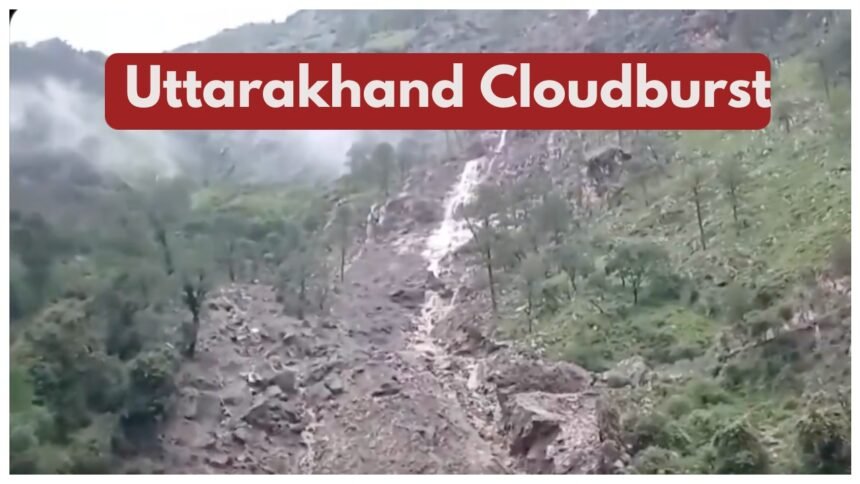A devastating cloudburst in Uttarkashi has turned serene mountain landscapes into a nightmare. On Tuesday, nature unleashed its fury in the high-altitude village of Dharali, triggering catastrophic mudslides and flash floods that swept away homes, hotels, and livelihoods in a matter of minutes.
The incident left at least four people dead, several missing, and dozens of properties destroyed. Heart-wrenching visuals released by the Indian Army capture the true scale of this disaster, showing torrents of water and debris racing through the settlement near Gangotri.
But what exactly happened in this remote part of Uttarkashi, and how are the rescue operations unfolding? Let’s break it down.
The Cloudburst That Shook Dharali
Imagine waking up to the sound of roaring water and earth splitting apart. That’s precisely what the residents of Dharali Uttarkashi experienced.
According to reports, the disaster was triggered by a massive cloudburst in the Kheer Ganga catchment area. Within minutes, heavy rainfall overloaded the fragile mountain terrain, sending walls of mud and debris crashing into the village. Locals described it as “the worst calamity in decades,” as the usually peaceful Kheer Ganga stream transformed into a violent torrent.
Rajesh Panwar, a villager, told the media that around 10–12 people might be buried under the debris while an estimated 20–25 hotels and homestays have been swept away. The sheer speed and scale of destruction have left even seasoned rescue teams stunned.
Chilling Army Footage: Nature’s Wrath Unfolds
Shortly after the disaster, the Surya Command of the Indian Army posted a haunting video on X (formerly Twitter). The footage shows muddy water mixed with rocks and debris tearing through the village like an unstoppable beast.
The Army captioned the video:
“A massive mudslide struck #Dharali village in the #KheerGad area near Harsil, triggering sudden flow of debris and water through the settlement.”
Troops from the #IbexBrigade were immediately deployed to the scene. They have since been assisting in damage assessment, search and rescue operations, and providing emergency support to terrified locals.
The Immediate Impact on Dharali
Dharali is a picturesque village and a key stopover on the route to Gangotri, famous for its hotels, restaurants, and homestays. Overnight, this thriving hub for pilgrims and tourists turned into a disaster zone.
According to Uttarkashi District Magistrate Prashant Arya, the cloudburst has already claimed at least four lives. Officials fear the death toll could rise as more bodies are recovered from the wreckage.
Homes, businesses, and essential infrastructure have been either severely damaged or washed away. For many locals, years of hard work and investment vanished in a matter of minutes.
Voices From the Ground
Eyewitnesses recall the harrowing moments when the floodwaters struck:
-
“Everything is finished,” one man was heard saying in a viral video, his voice trembling as he called out for missing relatives.
-
Another resident said, “We saw the water coming down like a monster… people ran, but it was too fast.”
Videos circulating online also show villagers frantically trying to contact their loved ones, while screams of panic and fear fill the background.
Relief and Rescue Operations in Full Swing
As soon as the disaster struck, the SDRF (State Disaster Response Force), NDRF (National Disaster Response Force), and local administration teams sprang into action. Working alongside the Army, these teams have been tirelessly searching for survivors under the rubble and evacuating stranded residents.
Chief Minister Pushkar Singh Dhami shared his concern on X, stating:
“The news of heavy losses due to the cloudburst in Dharali Uttarkashi is extremely sad and painful. Relief and rescue operations are underway on a war footing. I am in constant touch with officials and closely monitoring the situation.”
Helicopters and drones are being used to survey inaccessible areas, while medical teams are stationed nearby to treat the injured.
Why Cloudbursts Are Common in Uttarakhand
The Uttarkashi news may be shocking, but unfortunately, cloudbursts are not new to this region. Uttarakhand’s mountainous terrain, combined with intense monsoon activity, makes it highly prone to sudden, extreme weather events.
When moisture-laden air from the plains hits the Himalayas, it cools rapidly, releasing an intense downpour over a small area in a very short span. This phenomenon often leads to flash floods, landslides, and large-scale destruction.
How Dharali’s Geography Played a Role
Nestled along the banks of the Bhagirathi River, Dharali’s location is both a blessing and a curse. Its scenic beauty attracts thousands of tourists, but its proximity to steep slopes and narrow river valleys makes it vulnerable to disasters like this.
Experts believe that rapid construction, deforestation, and unchecked tourism development in Uttarkashi have further weakened the natural stability of the region, leaving it more exposed to the impact of cloudbursts.
The Humanitarian Crisis After the Disaster
Beyond the immediate destruction, the Dharali Uttarkashi cloudburst has created a humanitarian crisis. Dozens of families have been left homeless. Hotels and restaurants—the main sources of income for locals—have been destroyed, plunging the area into economic uncertainty.
Relief camps have been set up to provide shelter, food, and medical aid to those affected. However, accessibility remains a challenge due to blocked roads and damaged bridges, delaying the arrival of vital resources.
Government Response and Future Measures
While emergency measures are in full swing, the disaster has reignited debates about long-term solutions for disaster-prone regions like Uttarkashi. Experts are calling for:
-
Stricter regulations on construction in fragile zones.
-
Better forecasting technology for early cloudburst warnings.
-
Stronger infrastructure capable of withstanding flash floods.
-
Comprehensive disaster education programs for residents.
The Uttarakhand government has also promised compensation for affected families and financial support to rebuild homes and businesses.
Lessons for the Future
The Dharali tragedy is a grim reminder that the Himalayas, while breathtakingly beautiful, are extremely vulnerable to climate-driven disasters. As the frequency of such events increases, proactive planning and resilient infrastructure will be key to protecting lives and livelihoods in Uttarkashi and across Uttarakhand.
This disaster is not just a wake-up call for the state government, but for all of us. If unchecked, such natural calamities could become even deadlier in the years to come.
Read More: Former J&K Governor Satya Pal Malik Passes Away at 79: A Political Journey That Shaped History
Conclusion
The Uttarkashi cloudburst is more than just another headline—it’s a stark warning about the fragility of our mountain ecosystems and the urgent need for better disaster preparedness. Dharali’s devastation has left scars on the land and the hearts of its people, but it has also sparked a renewed determination among the authorities and citizens to rebuild stronger and smarter.
While the Army, SDRF, and NDRF continue their relentless rescue operations, one thing is clear: Uttarkashi will rise again—but it will take time, planning, and a commitment to change.







